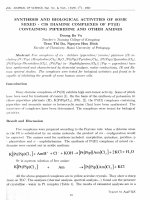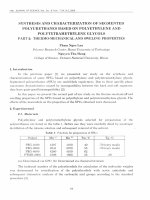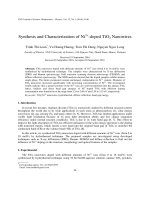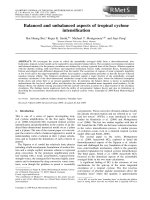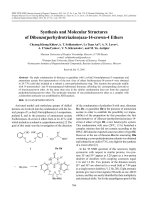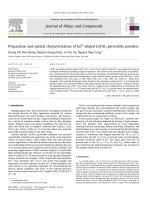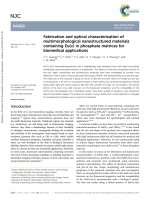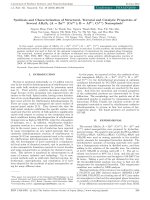DSpace at VNU: Synthesis and cytotoxic evaluation of novel dihydrobenzo[h] cinnoline-5,6-diones
Bạn đang xem bản rút gọn của tài liệu. Xem và tải ngay bản đầy đủ của tài liệu tại đây (748.66 KB, 9 trang )
Accepted Manuscript
Synthesis and cytotoxic evaluation of novel dihydrobenzo[h]cinnoline-5,6-diones
Tuyet Anh Dang Thi, Lena Decuyper, Hoang Thi Phuong, Doan Vu Ngoc, Ha
Thanh Nguyen, Tra Thanh Nguyen, Thanh Do Huy, Hung Huy Nguyen,
Matthias D’hooghe, Tuyen Van Nguyen
PII:
DOI:
Reference:
S0040-4039(15)30038-1
/>TETL 46668
To appear in:
Tetrahedron Letters
Received Date:
Revised Date:
Accepted Date:
16 June 2015
21 August 2015
31 August 2015
Please cite this article as: Thi, T.A.D., Decuyper, L., Phuong, H.T., Ngoc, D.V., Nguyen, H.T., Nguyen, T.T., Huy,
T.D., Nguyen, H.H., D’hooghe, M., Nguyen, T.V., Synthesis and cytotoxic evaluation of novel
dihydrobenzo[h]cinnoline-5,6-diones, Tetrahedron Letters (2015), doi: />2015.08.084
This is a PDF file of an unedited manuscript that has been accepted for publication. As a service to our customers
we are providing this early version of the manuscript. The manuscript will undergo copyediting, typesetting, and
review of the resulting proof before it is published in its final form. Please note that during the production process
errors may be discovered which could affect the content, and all legal disclaimers that apply to the journal pertain.
Graphical abstract
Synthesis and cytotoxic evaluation of novel dihydrobenzo[h]cinnoline-5,6-diones
1
Synthesis and cytotoxic evaluation of novel dihydrobenzo[h]cinnoline-5,6-diones
Tuyet Anh Dang Thi,a Lena Decuyper,b Hoang Thi Phuong,a Doan Vu Ngoc,a Ha Thanh Nguyen,a Tra
Thanh Nguyen,a Thanh Do Huy,a Hung Huy Nguyen,c Matthias D’hooghe,b,* Tuyen Van Nguyena,
a
Institute of Chemistry, Vietnam Academy of Science and Technology, 18-Hoang Quoc Viet, CauGiay, Hanoi, Vietnam
b
SynBioC Research Group, Department of Sustainable Organic Chemistry and Technology, Faculty of Bioscience Engineering, Ghent
University, Coupure Links 653, B-9000 Ghent, Belgium
c
Hanoi University of Science, 19-Le Thanh Tong str., Hoan Kiem, Hanoi, Vietnam
Abstract
A convenient one-pot multicomponent synthetic approach was developed en route to novel functionalized
dihydrobenzo[h]cinnoline-5,6-diones using 2-hydroxy-1,4-naphthoquinone, methylhydrazine and a variety of
aromatic aldehydes. Sixteen new derivatives were thus prepared and subsequently evaluated in terms of their
cytotoxicity profile, revealing a promising anticancer activity of nine of the compounds against KB and Hep-G2
human tumor cell lines.
Keywords: Dihydrobenzo[h]cinnoline-5,6-diones; Domino reactions; Naphthoquinones; Cytotoxicity
The quinone skeleton is ubiquitously present in nature as a constituent of biologically active
molecules in living organisms.1 Nowadays, quinones represent the second largest class of antitumor
agents approved by the FDA for clinical use.2 Their structural features make them particularly
appropriate to take part in several biological oxidation processes due to the redox properties linked
to the fully aromatic system.3 In this way, either one- or two-electron reduction provokes cellular
damage through direct alkylation of proteins and nucleic acids or oxidative stress to crucial cellular
macromolecules such as DNA, lipids and proteins, caused by the production of highly reactive oxygen
species.4 Accordingly, this class of compounds has attracted considerable attention in the field of
organic and medicinal chemistry within the pursuit of new bioactive agents. Among these, the
naphthoquinones, often substituted with heterocyclic groups, represent a valuable class of
compounds showing pronounced biological activities associated with, inter alia, antibacterial,5
antifungal,5 antiviral,6 antimalarial,7 trypanocidal,4a,5b,8 insecticidal,9 antiangiogenic10 and antiinflammatory11 properties. Furthermore, numerous examples of naphthoquinone compounds are
known for the treatment of skin diseases and different cancer types.3a,3b,5e Both 1,4- and, more rarely,
1,2-naphthoquinones occur naturally as toxic secondary metabolites of naphthalene, a principal
aromatic hydrocarbon present in ambient air. However, direct comparisons between the two
isomers have indicated that their reduction potentials are similar, while selectivity differences exist in
terms of their electrophilic reactions, which is translated into different biological targets and
associated activities.12
In continuation of our previous research on functionalized heterocyclic naphthoquinones,13 we
present herein the synthesis of novel dihydrobenzo[h]cinnoline-5,6-diones as cytotoxic agents,
starting from 2-hydroxy-1,4-naphthoquinones using a one-pot multicomponent domino reaction
(MDR). A domino reaction has been defined as a reaction involving two or more bond-forming
transformations, based on functionalities induced in the previous step, taking place without changing
the reaction conditions or adding catalysts and/or additional reagents. A multicomponent reaction
Tel.: +84 917683979 (TVN), +32 92649394 (MD), E-mail: (TVN), (MD)
2
involves at least three substrates and is considered to be a subgroup of domino reactions. 14 The
applicability of this green approach in organic synthesis is increasing continuously and is widely
accepted. This can be attributed to the high synthetic efficiency created by decreasing the number of
time-consuming reaction steps and laboratory operations required, the amount of chemicals and
solvents used and the waste produced.14,15 The synthesis of a considerable series of drug-like
compounds with high molecular complexity and structural diversity, including naphthoquinone-fused
heterocycles, is based on the aforementioned domino strategy. These have recently been described
in the literature and demonstrate the relevance of this topic in modern organic chemistry. 16
The synthesis of the dihydrobenzo[h]cinnoline-5,6-dione skeleton has only been described once
before, starting from 2,3-epoxy-1,4-naphthoquinones. The substrates were treated with active
methylene compounds in basic medium followed by subsequent reaction with hydrazine under acid
catalysis.17 In addition, their antioxidant and cytotoxic evaluation was performed. In line with our
previous research related to functionalized heterocyclic naphthoquinones,13g the synthesis of the
novel naphthoquinone derivatives was pursued in the present work by using a different approach. To
that end, a one-pot multicomponent domino strategy was employed starting from simple and readily
available substrates, namely 2-hydroxy-1,4-naphthoquinone 1, methylhydrazine 2 and aromatic
aldehydes 3. Thus, a solution of 2-hydroxy-1,4-naphthoquinone 1 and 2 equivalents of aromatic
aldehydes 3a-o in t-BuOH was heated under reflux for 30-60 min, after which a solution of
methylhydrazine 2 in t-BuOH was added. The resulting mixture was then further heated under reflux
for 2-3 h. In this way, 15 new fused naphthoquinones 4a-o were selectively obtained in 43-60% yield
after purification by silica gel column chromatography (Scheme 1, Table 1).18 The proposed molecular
structures of the functionalized naphthoquinones 4a-o were assigned by means of 1H NMR, 13C NMR
and IR analysis techniques. The mass spectra displayed the molecular ion signals at m/z (M+) values
pertaining to the molecular formulae. In addition, a single crystal X-ray analysis of compound 4f, as
depicted in Figure 1, provided irrefutable evidence for the formation of this uncommon
dihydrobenzo[h]cinnoline-5,6-dione heterocyclic skeleton.
Scheme 1. Synthesis of naphthoquinones 4a-o.
A possible mechanistic interpretation of this multicomponent reaction begins with the formation of
1,2,4-naphtalenetriones 6 by Knoevenagel condensation of 2-hydroxy-1,4-naphthoquinone 1 with
the aromatic aldehydes 3, followed by dehydration. Besides, the nucleophilic addition of
methylhydrazine 2 to a second equivalent of aromatic aldehydes 3 results in the formation of 1arylmethylidene-2-methylhydrazines 8, after elimination of water. Compounds 6 behave as Michael
acceptors for the addition of the in situ prepared hydrazones 8 (route a).19 The adducts undergo
tautomerization and intramolecular cyclization affording the fused naphthoquinone derivatives 11.
Keto-enol tautomerization and elimination of water finally lead to the title compounds 4 (Scheme 2).
However, other mechanistic proposals, such as for example condensation of hydrazone 8 with trione
3
6 at C4 (route b) to furnish an intermediate 12 prone to undergo electrocyclic cyclization toward
tricycle 13, followed by proton abstraction, should not be ruled out. The mechanism could be further
investigated by prestirring methylhydrazine 2 with an aromatic aldehyde (e.g. benzaldehyde 3a) and
2-hydroxy-1,4-naphthoquinone 1 with a different aldehyde (e.g. 4-methoxybenzaldehyde 3c) in order
to explore the possibility of having two different Ar-groups in the final product and the fidelity of
their incorporation, which could be an indication of reversibility.
Scheme 2. Proposed mechanisms for the formation of compounds 4.
Table 1. Synthesis of dihydrobenzo[h]cinnoline-5,6-diones 4a-o.
Entry
1
2
3
4
5
6
7
8
9
10
11
12
13
14
15
a
Ar
H
3-BrC6H4
4-MeOC6H4
3-MeOC6H4
Naphth-2-yl
4-BrC6H4
4-ClC6H4
3,4-OCH2O-C6H3
2-MeOC6H4
4-NO2C6H4
4-(MeSO2)C6H4
4-NMe2C6H4
4-HOC6H4
3-MeO-4-OH-C6H3
2-NO2-5-OH-C6H3
Compound (yield)a
a (50%)
b (51%)
c (53%)
d (47%)
e (47%)
f (45%)
g (43%)
h (53%)
i (60%)
j (51%)
k (48%)
l (45%)
m (45%)
n (43%)
o (47%)
After purification by column chromatography (SiO2).
4
Figure 1. Molecular structure of tricyclic compound 4f.
In order to broaden the reaction scope, the above-described reaction employing aliphatic aldehydes
was examined in the next part. For this purpose, cyclohexane carboxaldehyde and isobutyraldehyde
were used in combination with 2-hydroxy-1,4-naphthoquinone 1 and methylhydrazine 2 as the
starting materials. The reactions were followed via TLC analysis, however, only giving rise to highly
complex reaction mixtures. Apparently, an electrophilic benzylic position is required for this MCR to
proceed, resulting in reaction failure in the case of aliphatic aldehydes.
To evaluate their cytotoxic potential, the newly synthesized 1,2-naphthoquinone derivatives 4a-o
were subjected to in vitro biological assessment against two human cancer cell lines, KB and HepG2.20,21 The results of the cytotoxicity evaluation, as compared to the anticancer reference compound
ellipticine, are summarized in Table 2. As evidenced by these results, the majority of the derivatives
exhibit at least moderate cytotoxic activity against the KB and Hep-G2 cell lines. Nine of the new
dihydrobenzo[h]cinnoline-5,6-diones (4a, 4b, 4d, 4f, 4g, 4h, 4j, 4k, 4m) even display a considerable
activity profile with IC50-values below 5 µM against both cell lines, being only slightly higher than
those of the anticancer drug ellipticine. In particular, nitro compound 4j can be identified as the most
promising agent with IC50-values of 0.56 and 0.77 µM against the KB and Hep-G2 cell lines,
respectively. These results clearly suggest the relevance of this interesting new class of
dihydrobenzo[h]cinnoline-5,6-diones in the framework of cancer therapy research and medicinal
chemistry. Further optimization of the core structures toward potent cytotoxic agents should
definitely be considered in future research.
Both electron-donating and electron-withdrawing phenyl substituents were assessed in this study in
order to evaluate their influence on the reaction outcome and the subsequent biological testing.
However, no clear effect of the substitution pattern was observed on the yields (43-60%) (Table 1) as
well as on the IC50-values obtained during the cytotoxicity analyses (Table 2), pointing to the need for
further elaboration of the pharmacophore for the development of suitable structure-activity
relationships and the design of more potent dihydrobenzo[h]cinnoline-5,6-dione scaffolds.
5
Table 2. Cytotoxicity evaluation of the prepared naphthoquinone derivatives 4a-o.
Entry
Compound
1
2
3
4
5
6
7
8
9
10
11
12
13
14
15
16
4a
4b
4c
4d
4e
4f
4g
4h
4i
4j
4k
4l
4m
4n
4o
Ellipticine
IC50 (µM)
KB
3.70
3.43
23.86
4.58
7.42
2.29
3.60
2.87
>292
0.56
1.33
5.81
2.02
12.61
135.73
1.26
IC50 (µM)
Hep-G2
3.63
3.22
20.69
3.56
15.40
2.93
2.14
3.64
>292
0.77
2.71
16.85
4.46
10.93
145.90
1.42
In conclusion, the efficient and straightforward preparation of a series of functionalized
dihydrobenzo[h]cinnoline-5,6-diones was described, using a one-pot multicomponent approach
employing 2-hydroxy-1,4-naphthoquinone, methylhydrazine and a variety of aromatic aldehydes.
Subsequent biological assessment pointed out the relevance of a number of these novel scaffolds in
terms of their cytotoxic activity, implying their potential for further studies in the field of anticancer
research.
Acknowledgements
The authors are indebted to the Vietnamese National Foundation for Science and Technology
Development (NAFOSTED, code: 104.01-2013.27) and to Ghent University – Belgium (BOF) for
financial support.
References and notes
1
2
3
4
5
Thomson, R. H. Naturally occurring quinones; Academic Press: London and New York, 1971.
Powis, G. Free Radic. Biol. Med. 1989, 6, 63-101.
(a) O'Brien, P. J. Chem.-Biol. Interactions 1991, 80, 1-41; (b) Powis, G. Pharmac. Ther. 1987, 35, 57-162;
(c) Hillard, E. A.; de Abreu, F. C.; Ferreira, D. C. M.; Jaouen, G.; Goulart, M. O. F.; Amatore, C. Chem.
Commun. 2008, 23, 2612-2628.
(a) de Castro, S. L.; Emery, F. S.; da Silva Júnior, E. N. Eur. J. Med. Chem. 2013, 69, 678-700; (b) Bolton,
J. L.; Trush, M. A.; Penning, T. M.; Dryhurst, G.; Monks, T. J. Chem. Res. Toxicol. 2000, 13, 135-160.
(a) Omura, S.; Tanaka, H.; Koyama, Y.; Oiwa, R.; Katagiri, M.; Awaya, J.; Nagai, T.; Hata, T. J. Antibiot.
1974, 27, 363-365; (b) Fabri, R. L.; Grazul, R. M.; De Carvalho, L. O.; Coimbra, E. S.; Cardoso, G. M. M.;
De Souza-Fagundes, E. M.; Da Silva, A. D.; Scio, E. An. Acad. Bras. Cienc. 2012, 84, 1081-1089; (c)
Ambrogi, V.; Artini, D.; De Carneri, I.; Castellino, S.; Dradi, E.; Logemann, W.; Meinardi, G.; Di Somma,
6
6
7
8
9
10
11
12
13
14
15
16
M.; Tosolini, G. Br. J. Pharmacol. 1970, 40, 871-880; (d) Parisot, D. J. Antibiot. 1989, 42, 1189-1190; (e)
Kesteleyn, B.; De Kimpe, N.; Van Puyvelde, L. J. Org. Chem. 1999, 64, 1173-1179; (f) Visconti, A.; Surico,
G.; Iacobellis, N. S.; Bottalico, A. Phytopathol. Mediterr. 1983, 22, 152-156.
(a) da Costa, E. C. B.; Amorim, R.; da Silva, F. C.; Rocha, D. R.; Papa, M. P.; de Arruda, L. B.; MohanaBorges, R.; Ferreira, V. F.; Tanuri, A.; da Costa, L.; Ferreira, S. B. PLoS ONE 2013, 8:e82504,
doi:10.1371/journal.pone; (b) Crosby, I. T.; Bourke, D. G.; Jones, E. D.; Jeynes, T. P.; Cox, S.; Coates, J.
A. V.; Robertson, A. D. Bioorg. Med. Chem. Lett. 2011, 21, 1644-1648.
(a) Martin, Y. C.; Bustard, T. M.; Lynn, K. R. J. Med. Chem. 1973, 16, 1089-1093; (b) Pérez-Sacau, E.;
Estévez-Braun, A.; Ravelo, A. G.; Gutiérrez Yapu, D.; Giménez Turba, A. Chem. Biodivers. 2005, 2, 264274.
Guimarães, T. T.; Pinto, M. d. C. F. R.; Lanza, J. S.; Melo, M. N.; do Monte-Neto, R. L.; de Melo, I. M. M.;
Diogo, E. B. T.; Ferreira, V. F.; Camara, C. A.; Valença, W. O.; de Oliveira, R. N.; Frézard, F.; da Silva
Júnior, E. N. Eur. J. Med. Chem. 2013, 63, 523-530.
Pavela, R. Ind. Crops Prod. 2013, 43, 745-750.
(a) Lee, H. J.; Lee, H.-J.; Song, G.-Y.; Li, G.; Lee, J.-H.; Lü, J.; Kim, S.-H. Int. J. Cancer 2007, 120, 24812490; (b) Kayashima, T.; Mori, M.; Yoshida, H.; Mizushina, Y.; Matsubara, K. Cancer Lett. 2009, 278, 3440; (c) Jewess, P. J.; Chamberlain, K.; Boogaard, A. B.; Devonshire, A. L.; Khambay, B. P. S. Pest Manag.
Sci. 2002, 58, 243-247.
Moon, D.-O.; Choi, Y. H.; Kim, N.-D.; Park, Y.-M.; Kim, G.-Y. Int. Immunopharmacol. 2007, 7, 506-514.
Kumagai, Y.; Shinkai, Y.; Miura, T.; Cho, A. K. Annu. Rev. Pharmacol. Toxicol. 2012, 52, 221-247.
(a) Van Nguyen, T.; Kesteleyn, B.; De Kimpe, N. Tetrahedron 2001, 57, 4213-4219; (b) Van Nguyen, T.;
De Kimpe, N. Tetrahedron 2003, 59, 5941-5946; (c) Van Nguyen, T.; De Kimpe, N. Tetrahedron Lett.
2004, 45, 3443-3446; (d) Claessens, S.; Verniest, G.; El Hady, S.; Van Nguyen, T.; Kesteleyn, B.; Van
Puyvelde, L.; De Kimpe, N. Tetrahedron 2006, 62, 5152-5158; (e) Van Nguyen, T.; Claessens, S.;
Habonimana, P.; Abbaspour Tehrani, K.; Van Puyvelde, L.; De Kimpe, N. Synlett 2006, 2469-2471; (f)
Claessens, S.; Verniest, G.; Jacobs, J.; Van Hende, E.; Habonimana, P.; Van Nguyen, T.; Van Puyvelde, L.;
De Kimpe, N. Synlett 2007, 829-850; (g) Dang Thi, T. A.; Depetter, Y.; Mollet, K.; Thi Phuong, H.; Vu
Ngoc, D.; Pham The, C.; Thanh Nguyen, H.; Nguyen Thi, T. H.; Huy Nguyen, H.; D’hooghe, M.; Van
Nguyen, T. Tetrahedron Lett. 2015, 56, 2422-2425; (h) Dang Thi, T. A.; Vu Thi, T. H.; Thi Phuong, H.; Ha
Nguyen, T.; Pham The, C.; Vu Duc, C.; Depetter, Y.; Van Nguyen, T.; D’hooghe, M. Bioorg. Med. Chem.
Lett. 2015, 25, 3355-3358.
Pellissier, H. Chem. Rev. 2013, 113, 442-524.
(a) Tietze, L. F. Chem. Rev. 1996, 96, 115-136; (b) Brauch, S.; van Berkel, S. S.; Westermann, B. Chem.
Soc. Rev. 2013, 42, 4948-4962.
(a) Rajesh, S. M.; Bala, B. D.; Perumal, S.; Menéndez, J. C. Green Chem. 2011, 13, 3248-3254; (b)
Dabiri, M.; Tisseh, Z. N.; Bazgir, A. Dyes Pigments 2011, 89, 63-69; (c) Wu, L.; Zhang, C.; Li, W. Bioorg.
Med. Chem. Lett. 2014, 24, 1462-1465; (d) Katoh, T.; Monma, H.; Wakasugi, J.; Narita, K.; Katoh, T.
Eur. J. Org. Chem. 2014, 2014, 7099-7103; (e) Hueso-Falcón, I.; Amesty, Á.; Martín, P.; LópezRodríguez, M.; Fernández-Pérez, L.; Estévez-Braun, A. Tetrahedron 2014, 70, 8480-8487; (f)
Kanchithalaivan, S.; Sivakumar, S.; Ranjith Kumar, R.; Elumalai, P.; Ahmed, Q. N.; Padala, A. K. ACS
Comb. Sci. 2013, 15, 631-638; (g) Wen, L.-R. Org. Biomol. Chem. 2013, 11, 781-786; (h) Quiroga, J.;
Diaz, Y.; Bueno, J.; Insuasty, B.; Abonia, R.; Ortiz, A.; Nogueras, M.; Cobo, J. Eur. J. Med. Chem. 2014,
74, 216-224; (i) Verma, G. K.; Verma, R. K.; Shukla, G.; Anugula, N.; Srivastava, A.; Singh, M. S.
Tetrahedron 2013, 69, 6612-6619; (j) Buccini, M.; Jeow, S. Y.; Byrne, L.; Skelton, B. W.; Nguyen, T. M.;
Chai, C. L. L.; Piggott, M. J. Eur. J. Org. Chem. 2013, 2013, 3232-3240; (k) Menezes, J. C.; Faustino, M.
A.; de Oliveira, K. T.; Uliana, M. P.; Ferreira, V. F.; Hackbarth, S.; Röder, B.; Teixeira, T. T.; Furuyama,
T.; Kobayashi, N.; Silva, A. M.; Neves, M. G.; Cavaleiro, J. A. Chem. Eur. J. 2014, 20, 13644-13655; (l)
Khanna, G.; Chaudhary, A.; Khurana, J. M. Tetrahedron Lett. 2014, 55, 6652-6654; (m) Mahajan, S.;
Khullar, S.; Mandal, S. K.; Singh, I. P. Chem. Commun. 2014, 50, 10078-10081; (n) Brahmachari, G.;
7
17
18
19
20
21
Banerjee, B. ACS Sustainable Chem. Eng. 2014, 2, 411-422; (o) Prasanna, P.; Balamurugan, K.; Perumal
S.; Menéndez, J. C. Green Chem. 2011, 13, 2123-2129.
Berghot, M. A.; Kandeel, E. M.; Abdel-Rahman, A. H.; Marwa, A.-M. Med. Chem. 2014, 4, 381-388.
General procedure for the synthesis of dihydrobenzo[h]cinnoline-5,6-diones 4: A mixture of 2-hydroxy1,4-naphthoquinone 1 (1 equiv.) and aromatic aldehyde 3 (2 equiv.) in t-BuOH (5 mL/50 mg of 1) was
heated under reflux for 30-60 min, after which methylhydrazine 2 (1 equiv.) in t-BuOH was added. The
reaction was heated under reflux for another 2-3 h, followed by the addition of water and extraction
with EtOAc (three times). The combined organic phases were washed with water and dried (MgSO 4).
Finally, the solvent was removed in vacuo to afford the crude product, which was then purified by
column chromatography on silica gel (EtOAc/hexane, 3/7). 3,4-Bis(4-bromophenyl)-1-methyl-1,4dihydrobenzo[h]cinnoline-5,6-dione 4f: violet crystals, 45% yield. Mp 179-180°C. IR (KBr): 3443;
-1 1
3048; 2928; 1687; 1624; 1529; 1480; 1372; 1254; 1067; 1007; 939; 818; 773 cm . H NMR (CDCl3, 500
MHz): 8.09 (1H, dd, J = 1.0, 7.5 Hz); 7.80 (1H, d, J = 7.5 Hz); 7.72 (2H, d, J = 8.5 Hz); 7.63 (1H, dt, J =
1.5, 8.0 Hz); 7.51 (1H, t, J = 8.0 Hz); 7.49 (2H, d, J = 8.5 Hz); 7.36 (2H, d, J = 8.5 Hz); 7.17 (2H, d, J = 8.5
13
Hz); 5.62 (1H, s); 4.10 (3H, s). C NMR (CDCl3, 125 MHz): 179.9; 176.6; 149.4; 147.1; 139.3; 133.7;
132.8; 132.2; 131.9; 131.5; 130.6; 130.4; 130.2; 129.1; 128.6; 126.8; 125.4; 121.4; 109.2; 46.4; 34.8.
+
HRMS (ESI) [M+H] : Calcd. for C25H16Br2N2O2: 533.9579, Found: 533.9567 and 535.9553.
(a) Mantenuto, S.; Mantellini, F.; Favi, G.; Attanasi, O. A. Org. Lett. 2015, 17, 2014-2017; (b) Serrano, I.;
Monge, D.; Álvarez, E.; Fernández, R.; Lassaletta, J. M. Chem. Commun. 2015, 51, 4077-4080; (c) Yang,
H.-B.; Zhao, Y.-Z.; Sang, R.; Shi, M. J. Org. Chem. 2014, 79, 3519-3528; (d) Wu, W.; Yuan, X.; Hu, J.; Wu,
X.; Wei, Y.; Liu, Z.; Lu, J. Org. Lett. 2013, 15, 4524-4527.
Cell culture and cell viability assay. Two human cancer cell lines (epidermoid carcinoma cell line (KB)
and hepatoma carcinoma cell line (HepG2)), obtained from the American Type Culture Collection
(USA) ATCC, were used for cytotoxic evaluation. The cells were grown in RPMI 1640 medium
supplemented with 10% fetal bovine serum, 100 U/mL penicillin, and 100 µg/mL streptomycin at 37°C
in a humidified atmosphere (95% air and 5% CO2). The exponentially growing cells were used
throughout the experiments. The inhibitory effects of the compounds on the growth of the human
cancer cell lines were determined by measuring the metabolic activity using a 3-[4,5-dimethylthiazol2-yl]-2,5-diphenyltetrazolium bromide (MTT) assay.21 Briefly, human cancer cell lines (1×105 cells/mL)
were treated for 3 days with a series of concentrations of the compounds (in DMSO): 0.125, 0.5, 2.0,
8.0, 32.0, and 128.0 µg/mL. After incubation, 0.1 mg MTT solution (50 µL of a 2 mg/mL solution) was
added to each well, and the cells were then incubated at 37°C for 4 h. The plates were centrifuged at
1000 rpm for 10 min at room temperature, and the media were then carefully aspirated.
Dimethylsulfoxide (150 µL) was added to each well to dissolve the formazan crystals. The plates were
read immediately at 540 nm on a microplate reader (TECAN GENIOUS). All the experiments were
performed three times, and the mean absorbance values were calculated. The results are expressed as
the percentage of inhibition that produced a reduction in the absorbance by the treatment of the
compounds compared to the untreated controls. A dose-response curve was generated, and the
inhibitory concentration of 50% (IC50) was determined for each compound as well as each cell line.
Carmichael, J.; DeGraff, W. G.; Gazdar, A. F.; Minna, J. D.; Mitchell, J. B. Cancer Res. 1987, 47, 936-942.
8


